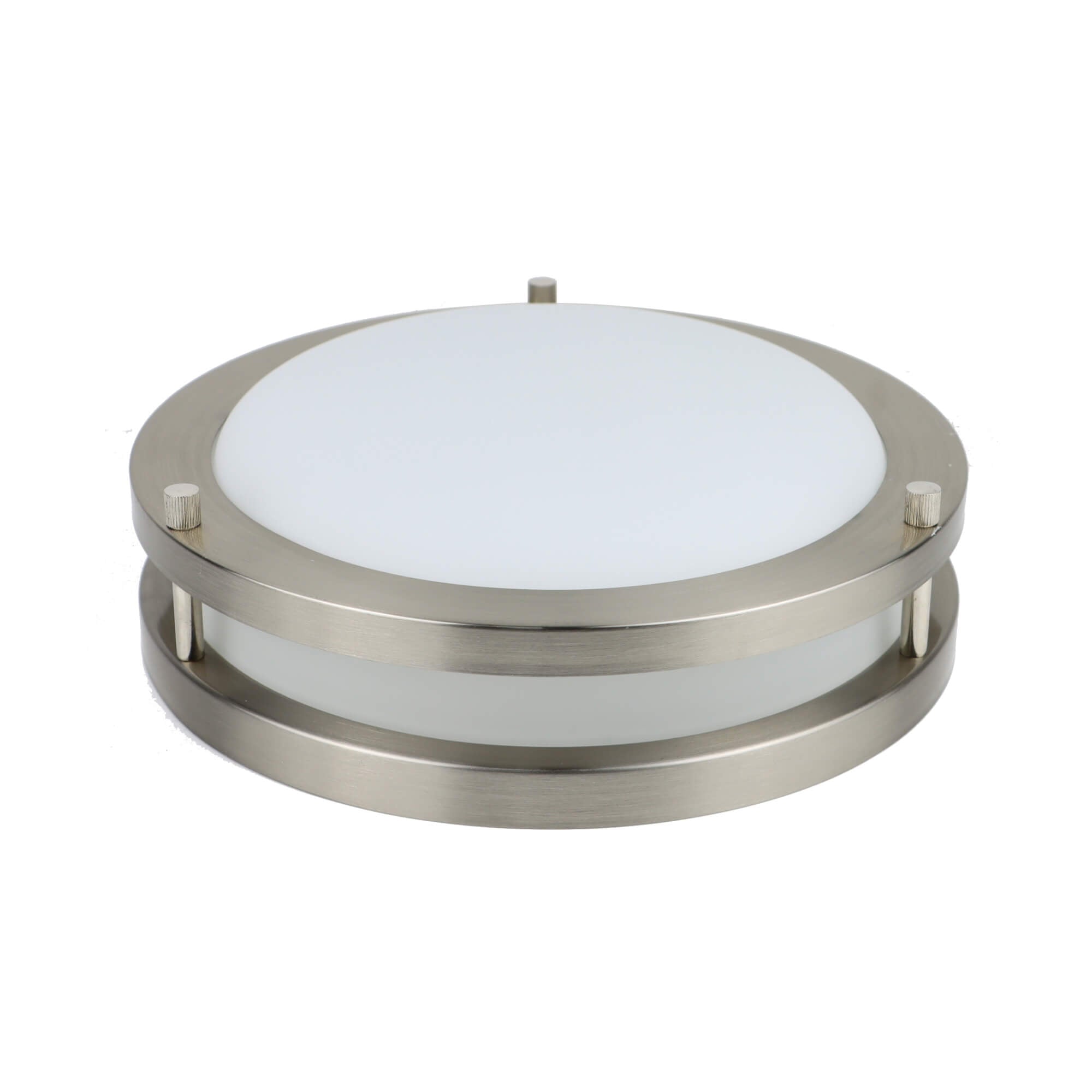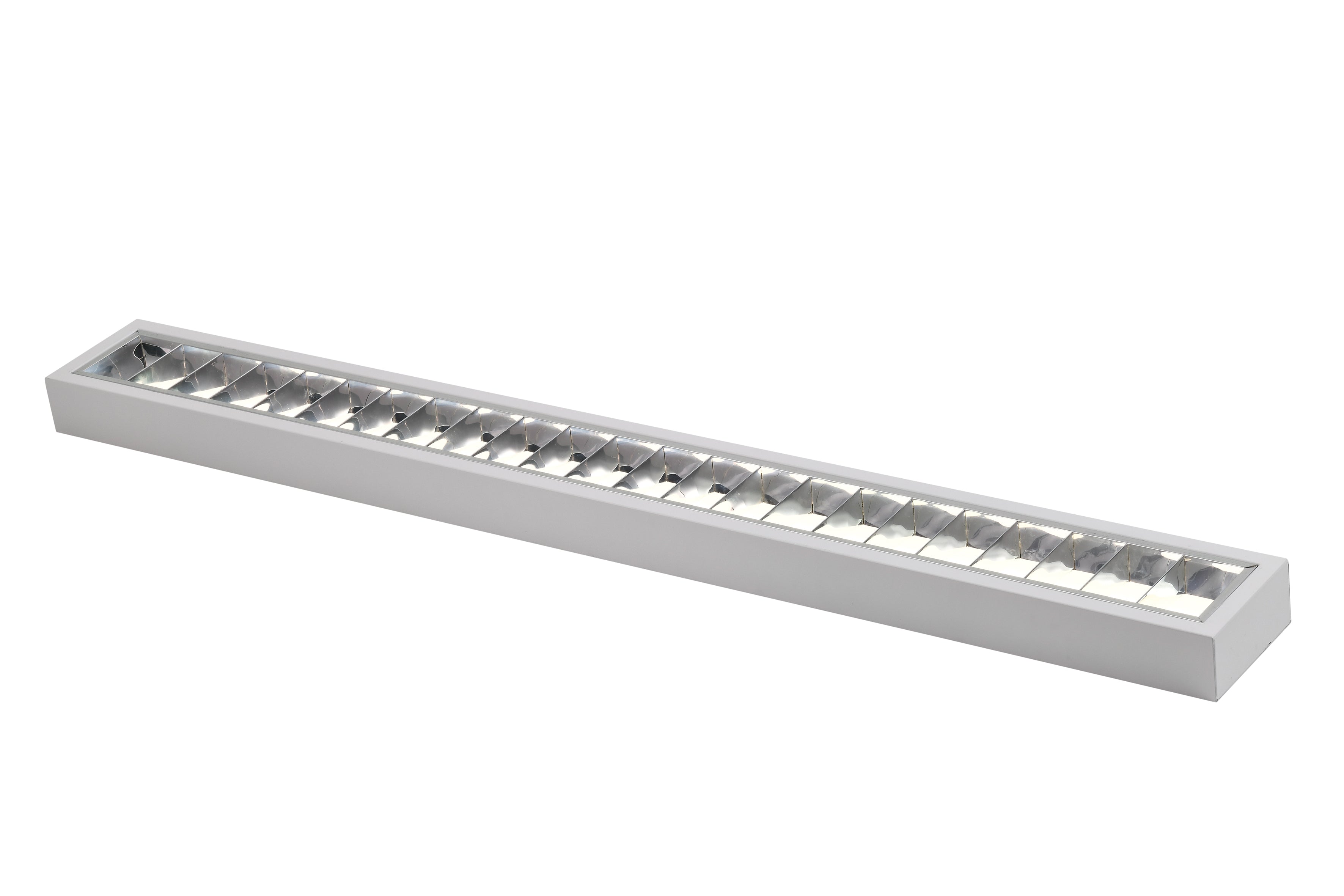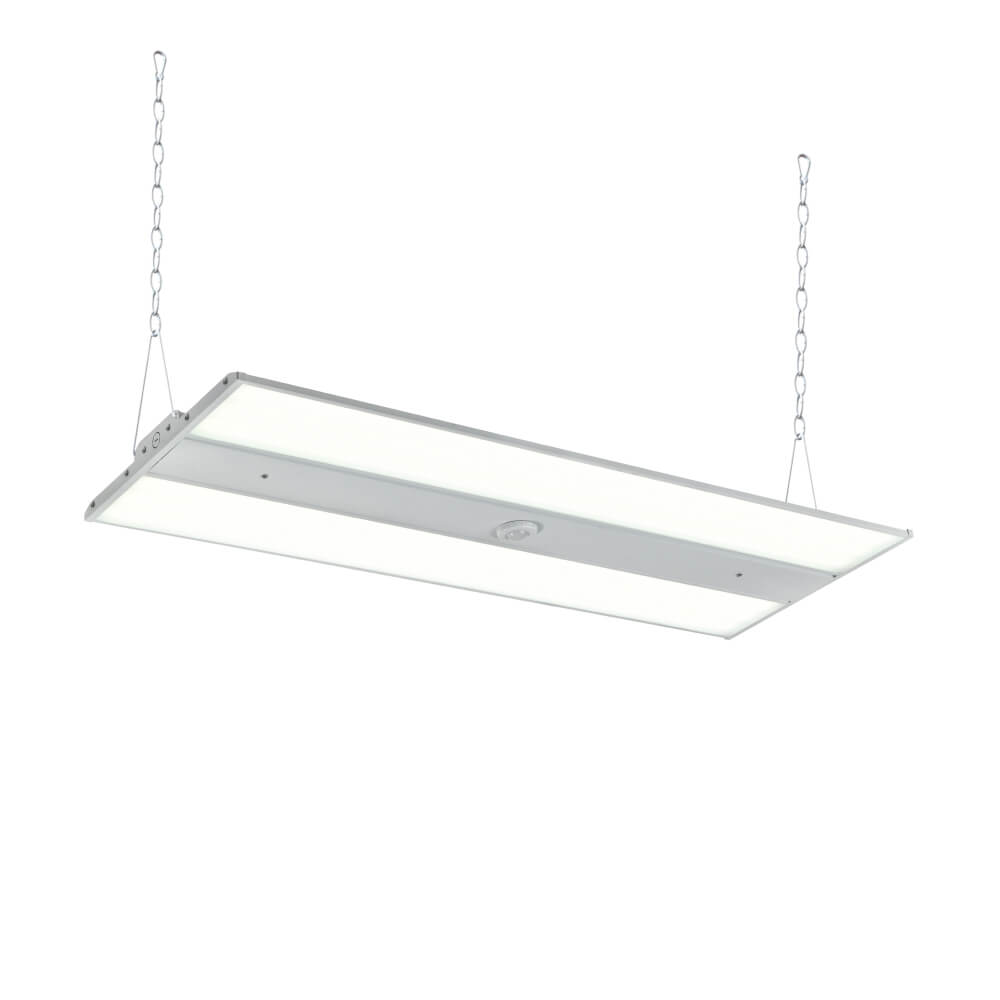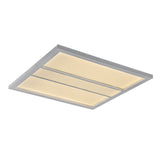Color Rendering Index: What is CRI? 2024 Updated
| CRI Range | Color Rendering Quality | Recommended Uses |
|---|---|---|
| 0-39 | Very Poor | Not suitable for most applications |
| 40-69 | Below Average | Non-critical commercial/industrial |
| 70-79 | Fair | General use, some commercial |
| 80-89 | Good | Residential, offices |
| 90-100 | Excellent | Art galleries, photography, healthcare |

Over the past decade, LED lighting has rapidly gained popularity and market share in commercial spaces like retail stores, restaurants, offices, healthcare facilities, and more. Compared to legacy lighting technologies like incandescent and fluorescent, LEDs offer superior longevity, efficiency, and design flexibility. However, one often overlooked specification that is critical for commercial applications is the Color Rendering Index (CRI).
The CRI rating indicates how accurately a light source reproduces colors compared to natural daylight. High CRI LED lighting renders colors vividly and faithfully, while low CRI can distort hues or mute tones. Selecting fixtures with the proper CRI level is essential for businesses where color quality impacts merchandise presentation, food appearances, artwork displays, medical examinations, and more.
This article will explain the CRI system and its significance in commercial spaces. We'll explore why color accuracy matters, review CRI requirements for different applications, and provide tips for choosing LED lighting tailored to your needs. With a solid understanding of CRI, facility managers and business owners can make informed lighting decisions that create optimal environments.
What Is CRI and Why Does It Matter?
The Color Rendering Index is a quantitative metric that measures how accurately a light source displays colors compared to an ideal reference light. The reference is either incandescent light at the same color temperature or natural daylight at roughly 5000K to 6000K.
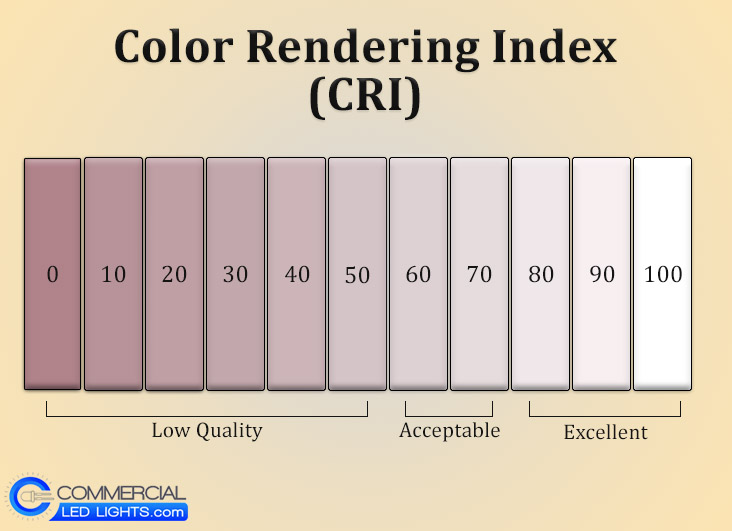
Image: Comparison between low and high CRI LED lighting from Commercial LED lights.com
CRI is expressed as a 0-100 scale, where 0 represents the poorest color rendering and 100 is a perfect score. The higher the CRI, the better and more accurate colors will appear under the light source.
Some key facts about CRI:
- Incandescent bulbs provide near-perfect color rendering with a CRI around 95-100.
- Natural daylight has a CRI of 100.
- CRI differs from color temperature, which measures warmness or coolness on the Kelvin scale.
- CRI is vital for tasks requiring accurate color vision and discrimination.
For businesses, choosing appropriate CRI levels based on activities in the space creates the optimal environment for customers and employees. We'll explore why it matters in more depth next.
The Importance of CRI in Commercial Settings
The ability to see colors naturally and distinctly is critical in many commercial environments. Using LED lights with suitable CRI ratings helps create the ideal setting for merchandising, healthcare, food services, design work, and more.
Retail Stores and Showrooms
In retail stores, customers want to view products like clothing, home goods, cosmetics, and electronics in their true colors before purchasing. But lighting with low CRI can distort hues or mute color intensities, leading customers to pass over items. Studies show shoppers prefer stores lit with a 95 CRI source and make better perceptions about merchandise quality. With higher CRI LED lighting, retailers can display products in the best light and improve sales.
Art Galleries and Museums
Galleries and museums require spot-on color accuracy so artworks and artifacts are represented as their creators intended. Natural-looking lighting brings out intricate textures not noticeable under poor-quality light. For realistic color rendering crucial to these institutions, LED luminaires with a CRI over 90 are standard.
Restaurants and Hospitality
In restaurants, high CRI rating LEDs enhance the appearance of food, providing desirable visual appeal for patrons. Under low CRI fluorescent or incandescent lighting, meals can seem unappetizing. Quality LED lighting also creates the right ambiance for hospitality venues through features like color-tuning.
Healthcare Settings
LED lighting with high CRI plays an important role in healthcare by providing clinical staff with superior visual conditions for tasks like examinations, wound inspection, surgery, and newborn care. Accurately rendering colors like skin tones or blood oxygenation levels aids healthcare professionals in assessments and diagnoses.
Creative Services and Production
For creative professions like photography, videography, graphic design, printing, textiles, paint mixing, and furniture building, LEDs with CRI over 90 are a must for color-critical work. Anything lower than 80 CRI can jeopardize matching colors properly. Even small hue shifts under low CRI lighting distort the final products.
Office Spaces
While color fidelity is less critical in general office lighting, high CRI LEDs provide a comfortable, natural quality of light that makes employees more productive and focused. Cool white tunable LEDs with 80+ CRI are ideal for computer tasks and paperwork.
In summary, businesses want to match CRI levels to the color rendering needs of the application, from retail clothing displays to hospital operating rooms. Professionals seeking to showcase, sell, create, or simply appreciate color need LEDs that faithfully reproduce the entire spectrum.
Factors That Influence CRI Ratings
The CRI score of a light is dependent on the intrinsic qualities of the lamp itself. Here are some of the key factors that affect where a light source falls on the CRI scale:
- Spectral power distribution - This refers to the wavelengths emitted by the lamp and the intensity across the color spectrum. Lights weighted more heavily in certain wavelengths or missing parts of the spectrum will have lower CRI.
- Phosphor composition - LEDs use phosphors to convert the blue light produced by chips into broader spectrum white light. The specific makeup and quality of these phosphors greatly impacts CRI.
- Lamp technology - Incandescent and halogen bulbs inherently produce light close to a blackbody radiator, resulting in very high CRI. LEDs and fluorescents require modifications to achieve high CRI.
- Manufacturing variances - There can be small discrepancies between otherwise identical products, altering the spectral output and CRI ratings slightly. Using LEDs all from the same product family helps minimize inconsistency.
- Voltage - Running lamps at anything less than the rated voltage can affect spectral distribution and lower CRI.
- Dimming - With some legacy technologies like CFLs and fluorescent tubes, dimming can reduce CRI. LED dimming done properly does not change CRI significantly.
- Lumen depreciation - As lamps age and light output decreases, color rendering can worsen. LEDs experience negligible lumen depreciation over their lifetime.
Being aware of these influencing factors allows commercial buyers to select luminaires engineered for optimal CRI from reputable manufacturers.
CRI Recommendations for Applications
When evaluating and comparing LED lighting options, here are some general CRI guidelines tailored to different commercial spaces:
- Retail: Look for CRI of 90-95+ to display merchandise optimally.
- Art galleries/museums: CRI of 95-100 is needed for accurate color rendering.
- Restaurants:Aim for CRI 90+ to showcase food appealingly.
- Offices: Minimum 80 CRI for comfortable, glare-free workspace lighting.
- Healthcare: 90+ CRI required for clinical settings and examinations.
- Photography/video: 95+ CRI is standard for studio lighting and location shoots.
- Graphic design/printing: Require minimum 90 CRI lights for color matching and proofs.
- Auto services: 80+ CRI helps identify paint colors, leaks, and underhood details.
- Warehouses: General lighting needs can be met with 70+ CRI LED high bay fixtures.
Higher CRI comes at a cost premium, so strike a balance between adequate color rendering and budget. Prioritize critical areas like retail clothing sections or hospital operating rooms for the highest CRI fixtures.

Tunable White and Full Spectrum LEDs
To achieve excellent color rendering plus added benefits, consider tunable white or full spectrum LED lighting.
Tunable white LEDs allow users to adjust the color temperature, measured in Kelvin, from a warm glow around 2700K to an energizing bright 6000K light or anything in between. This gives flexibility to create varied lighting scenes. CRI remains consistent across the tuning range.
Full spectrum LEDs strive to replicate natural daylight's full visual range. This spans all visible wavelengths from around 400nm deep blue up to 700nm deep red. By providing the most complete spectrum, full-spectrum LEDs can attain CRI of 95-98+, optimal for very color-sensitive applications.
Both technologies provide high-quality, adaptable lighting controllable to meet each user's needs.
Latest Innovations
Here are some of the latest innovations related to CRI in LED lighting:
- Improved phosphor formulations - Phosphors are used in LEDs to convert blue light into broader spectrum white light. Engineers have refined phosphor mixes, achieving higher CRI with greater efficiency and stability.
- Multi-layer phosphor coatings - Applying distinct phosphor layers to LED chips allows more precise tuning of the spectral output. This expands color rendering capabilities.
- Alternative semiconductor materials - Moving beyond traditional silicon carbide and sapphire LED platforms to GaN-on-GaN and other advanced compounds enables expanded wavelength options.
- Nano-engineered structures - Nanoscale architectures applied to LED wafers interactions between photons, electrons and materials to enhance spectral power distribution and CRI.
- Quantum dot technology - Tiny semiconductor crystals applied as films on LED chips or packages allow LEDs to emit highly saturated, narrowband light leading to wider color gamuts and CRI over 90.
- Spectral tuning - Onboard sensors and microcontrollers automatically adjust output to maintain optimal spectrum and consistent CRI throughout LED lifespan, despite efficiency changes.
- Packaged color-mixed emitters - Integrating red, green, blue and white LED chips within a single package allows software controlled tuning of flux ratios for high CRI at various color temps.
- Non-phosphor color conversion - Using quantum dots or nanocrystals rather than traditional phosphors for wavelength conversion provides superior spectral control and CRI.
These and other emerging solutions push LED lighting to the next level, where high CRI and quality illumination are inherent features across the board.
